How to Integrate Remote Patient Monitoring Software: Complete Guide for Healthcare Providers
Remote patient monitoring software has revolutionized healthcare delivery by enabling continuous patient care outside traditional clinical settings. This comprehensive guide explores RPM integration strategies, top platforms, essential features, and implementation best practices for healthcare providers seeking to enhance patient outcomes while reducing operational costs.
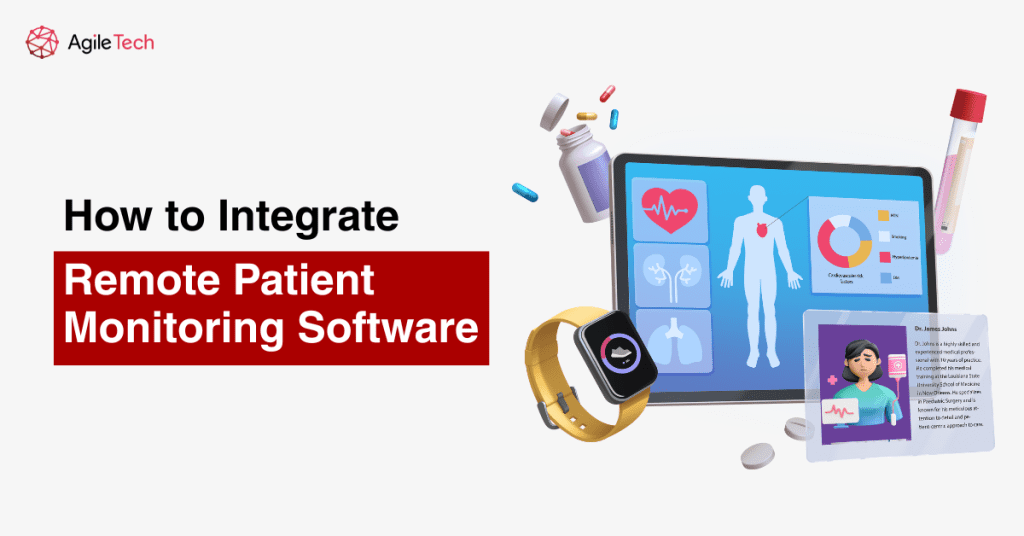
- 1. What is Remote Patient Monitoring Software?
- 2. How Healthcare Businesses Benefit from RPM Solutions?
- 3. Key Features of RPM Software
- 4. 7 Best Remote Patient Monitoring Platforms
- 5. How to Successfully Adopt Remote Patient Monitoring in Healthcare
- 6. AgileTech Experience in Remote Patient Monitoring Integration
- 7. Conclusion
- FAQs
1. What is Remote Patient Monitoring Software?
Remote patient monitoring software represents a transformative healthcare technology that enables medical professionals to track patient health data outside traditional clinical environments. This sophisticated digital infrastructure collects, analyzes, and transmits vital health information from patients’ homes directly to healthcare providers, creating a continuous care ecosystem that bridges the gap between scheduled medical appointments.
The foundation of remote patient monitoring solutions lies in their ability to capture real-time physiological data through connected medical devices, wearable sensors, and mobile health applications. These systems automatically gather information including blood pressure readings, glucose levels, heart rate variability, oxygen saturation, weight measurements, and other critical health indicators. The collected data flows seamlessly into centralized healthcare databases where medical professionals can monitor patient conditions, identify concerning trends, and intervene promptly when necessary.
Modern remote patient monitoring platforms integrate sophisticated algorithms and artificial intelligence capabilities to analyze incoming data streams continuously. These intelligent systems can detect anomalies, predict potential health complications, and generate automated alerts when patient parameters exceed predetermined thresholds. This proactive approach enables healthcare providers to shift from reactive treatment models to preventive care strategies, ultimately improving patient outcomes while reducing healthcare costs.
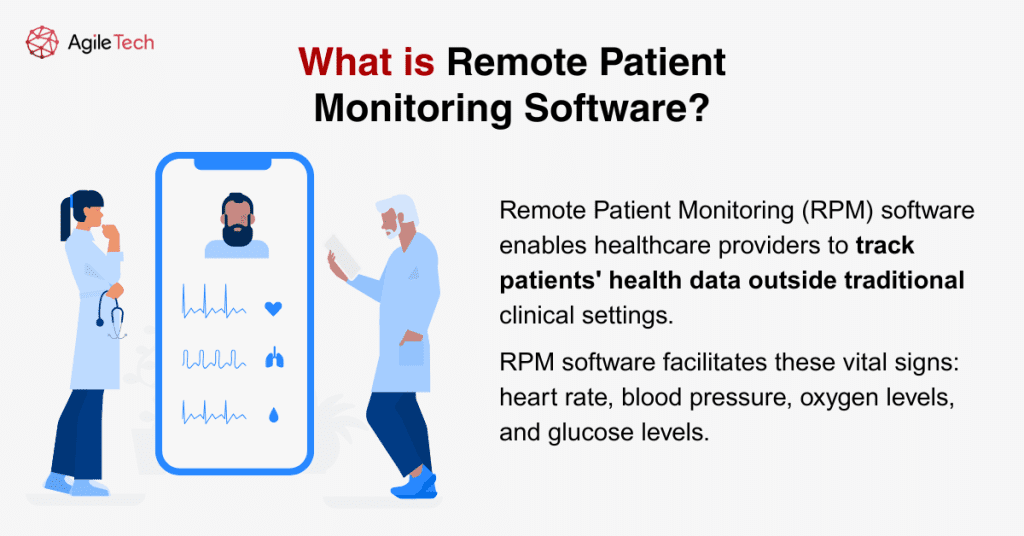
Why is RPM important?
The significance of remote patient monitoring software extends far beyond technological innovation, addressing fundamental challenges within contemporary healthcare systems. Healthcare organizations worldwide face mounting pressure to deliver high-quality care while managing escalating costs, staffing shortages, and increasing patient volumes. Remote patient monitoring solutions provide a strategic response to these challenges by enabling more efficient resource allocation and expanding care reach without proportional increases in infrastructure investment.
Patient safety represents a primary driver for RPM adoption across healthcare institutions. Traditional healthcare models often create gaps between scheduled appointments, during which patients with chronic conditions may experience health deterioration without immediate medical attention. Remote patient monitoring software eliminates these dangerous intervals by providing continuous surveillance capabilities that detect early warning signs of medical complications.
The economic implications of remote patient monitoring implementation are substantial and multifaceted. Healthcare organizations report significant cost reductions through decreased hospital readmission rates, reduced emergency department utilization, and optimized staffing allocations. Patients benefit from reduced travel expenses, fewer missed work days, and decreased out-of-pocket medical costs associated with frequent clinic visits.
Common Types of Remote Patient Monitoring Solutions
The landscape of remote patient monitoring solutions encompasses diverse technological approaches designed to address specific healthcare needs and patient populations.
Chronic Disease Management Platforms
- Designed for ongoing monitoring of long-term conditions.
- Common use cases: diabetes, hypertension, heart failure, and COPD.
- Help track vital signs and trends over time to adjust treatment plans.
Post-Acute Care Monitoring Solutions
- Focus on patients recently discharged from hospitals or post-surgery.
- Track wound healing, pain levels, medication adherence, and recovery milestones.
- May include imaging tools (e.g., smartphone cameras) for remote wound assessment..
Mental Health Monitoring Solutions
- Support psychological wellness through remote tools.
- Features include mood tracking, sleep pattern analysis, and activity monitoring.
- Useful for managing anxiety, depression, and other mental health conditions.
2. How Healthcare Businesses Benefit from RPM Solutions?
2.1. Clinical Outcome Improvements
Healthcare organizations implementing remote patient monitoring software experience transformative operational and clinical benefits that extend throughout their entire care delivery infrastructure. Clinical outcome improvements represent the most significant benefit category for healthcare businesses adopting remote patient monitoring platforms. Organizations consistently report reduced hospital readmission rates, decreased emergency department utilization, and improved chronic disease management outcomes among patients enrolled in RPM programs.
The proactive nature of remote patient monitoring integration allows healthcare providers to identify concerning health trends weeks or months before they would become apparent through traditional appointment-based care models. This early detection capability enables preventive interventions that maintain patient stability and avoid costly medical complications. Healthcare organizations report up to forty percent reductions in hospital readmissions among patients participating in comprehensive RPM programs, translating directly into improved quality metrics and reduced financial penalties associated with excessive readmission rates.
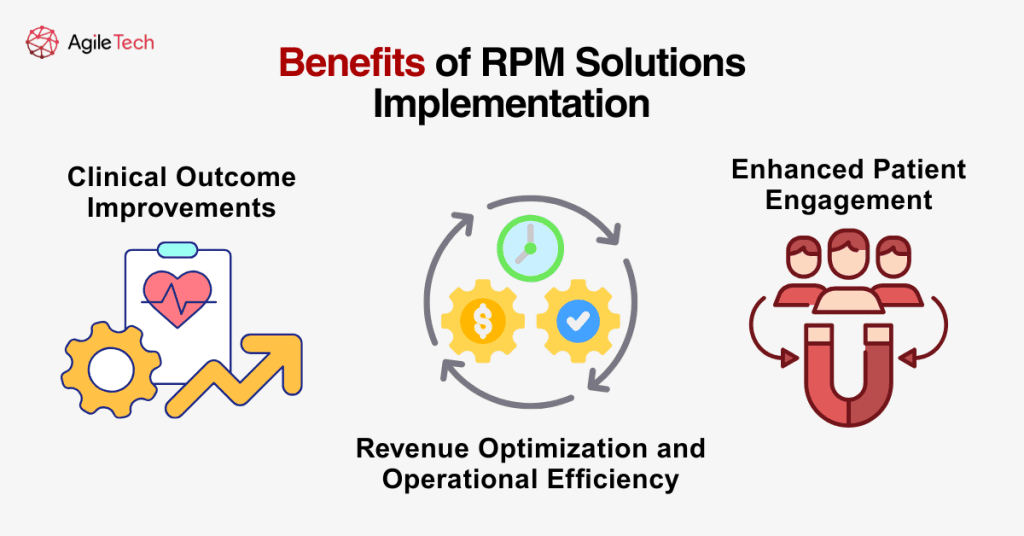
2.2. Revenue Optimization and Operational Efficiency
Revenue optimization through remote patient monitoring implementation occurs through multiple mechanisms that enhance organizational financial performance. Medicare and private insurance reimbursement for RPM services provide new revenue streams that help offset traditional fee-for-service volume declines. Healthcare organizations can bill for device setup, data transmission, clinical data review, and patient education services associated with remote monitoring programs.
Operational efficiency gains from patient monitoring solutions enable healthcare organizations to optimize resource allocation and expand care capacity without proportional infrastructure investment. Clinical staff can monitor multiple patients simultaneously through centralized dashboards, increasing productivity and enabling more efficient use of specialized healthcare expertise. Automated alert systems prioritize attention toward patients requiring immediate intervention while allowing stable patients to continue monitoring with minimal direct supervision.
2.3. Enhanced Patient Engagement
Patient engagement and satisfaction metrics improve significantly when healthcare organizations implement comprehensive remote patient monitoring solutions. Patients appreciate the convenience of home-based monitoring, the sense of security provided by continuous oversight, and the stronger relationships they develop with their healthcare providers through regular virtual interactions. These improvements in patient experience translate into better health outcomes, increased patient retention, and positive reputation enhancement that supports organizational growth.
3. Key Features of RPM Software
3.1. Real-Time Data Collection and Transmission
Comprehensive remote patient monitoring software platforms incorporate sophisticated features that enable seamless data collection, analysis, and clinical decision support across diverse healthcare environments. Real-time data collection and transmission capabilities form the foundation of effective remote patient monitoring platforms. Advanced RPM software supports integration with multiple device types, including blood pressure monitors, glucometers, pulse oximeters, weight scales, activity trackers, and specialized medical sensors.
The sophistication of data collection extends beyond simple measurement capture to include contextual information that enhances clinical interpretation. Modern platforms record environmental factors, medication timing, activity levels, and patient-reported symptoms alongside physiological measurements. This comprehensive data-gathering approach provides healthcare providers with complete pictures of patient health status that enable more accurate clinical assessments and treatment adjustments.
3.2. Clinical Dashboard and Visualization
Clinical dashboard and visualization tools represent critical components that transform complex medical data into actionable insights for healthcare providers. Effective RPM platforms present patient information through intuitive interfaces that highlight concerning trends, display historical patterns, and prioritize patients requiring immediate attention. Advanced visualization capabilities include customizable alerting thresholds, trend analysis graphs, and comparative reporting tools that support efficient clinical workflow management.
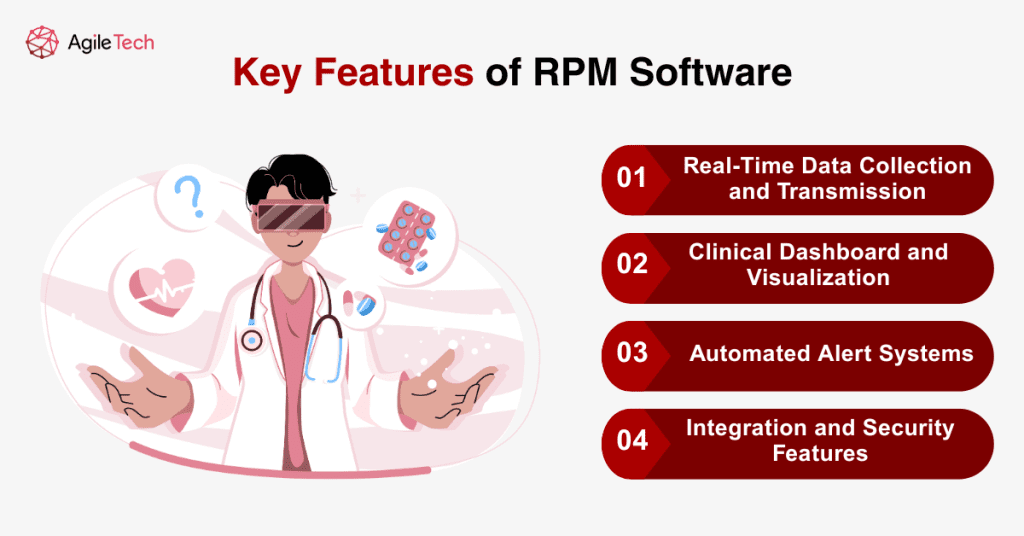
3.3. Automated Alert Systems
Automated alert and notification systems provide essential safety mechanisms that ensure critical health changes receive immediate attention from appropriate healthcare providers. Sophisticated alerting algorithms analyze incoming data streams continuously and generate notifications when patient parameters exceed predetermined thresholds or exhibit concerning patterns. These systems support multiple communication channels, including secure messaging, email notifications, phone alerts, and integration with existing healthcare communication systems.
3.4. Integration and Security Features
Integration capabilities with existing healthcare infrastructure represent fundamental requirements for successful remote patient monitoring platform adoption. Leading RPM solutions provide seamless connectivity with electronic health record systems, practice management platforms, billing software, and clinical decision support tools. This integration eliminates data silos and ensures that remote monitoring information becomes part of comprehensive patient health records that support coordinated care delivery.
Security and compliance features ensure that remote patient monitoring platforms meet stringent healthcare data protection requirements while maintaining system reliability and performance. Advanced RPM software incorporates end-to-end encryption, multi-factor authentication, audit logging, and role-based access controls that protect sensitive health information throughout the monitoring process.
4. 7 Best Remote Patient Monitoring Platforms
Enterprise-Level Solutions
Philips HealthSuite Digital Platform
- A comprehensive RPM solution with advanced clinical capabilities and strong infrastructure.
- Supports broad device integration, advanced data analytics, and efficient clinical workflows.
- Particularly strong in clinical decision support and hospital system integration. Ideal for large healthcare organizations with complex needs.
Epic’s MyChart and Care Everywhere Integration
- Integrates RPM capabilities directly into the widely adopted Epic EHR system.
- Seamless monitoring data integration with clinical documentation workflows.
- Best suited for healthcare organizations already using Epic for unified patient data management.
Specialized Care Solutions
Teladoc Health’s RPM Solutions
- Combines RPM features with telehealth services to offer a full virtual care ecosystem.
- Known for scalability and high patient engagement.
- Suitable for both small practices and large health systems.
Medtronic’s CareLink Network
- Specializes in cardiac device monitoring and chronic disease management, especially diabetes.
- Combines reliable devices with robust software for clinical accuracy.
- Ideal for intensive monitoring of high-risk populations.
Cost-Effective Options
100Plus RPM Platform
- Cloud-based and designed for affordability and ease of implementation.
- Offers essential RPM functions: clinical alerts, reporting, and patient engagement tools.
- Well-suited for small healthcare organizations and practices.
CareValidate RPM
- Focuses on chronic care and post-surgical recovery.
- Offers user-friendly design, automated engagement tools, and customizable protocols.
- Supports quality improvement and compliance initiatives.
Health Recovery Solutions (HRS)
- Strong in post-acute care and chronic disease management.
- Features include monitoring tools, patient education, and care coordination.
- Excels in care transitions and long-term patient engagement.
5. How to Successfully Adopt Remote Patient Monitoring in Healthcare
5.1. Strategic Planning and Assessment
Successful implementation of remote patient monitoring software requires strategic planning, comprehensive stakeholder engagement, and a systematic approach to technology adoption that addresses both clinical and operational considerations. The initial phase of remote patient monitoring integration begins with a comprehensive needs assessment and strategic planning activities that establish clear objectives and success metrics for the implementation project.
Healthcare organizations should conduct thorough evaluations of their current patient populations, identifying specific conditions and patient groups that would benefit most from remote monitoring capabilities. This assessment should include analysis of hospital readmission patterns, emergency department utilization trends, and chronic disease management outcomes to identify areas where RPM implementation could generate the greatest clinical and economic impact.
5.2. Stakeholder Engagement and Infrastructure Preparation
Stakeholder engagement represents a critical success factor that requires early and sustained involvement from clinical staff, administrative leadership, information technology teams, and patient representatives. Successful RPM implementations require buy-in from physicians, nurses, and support staff who will integrate monitoring data into their daily clinical workflows. Administrative leaders must understand the financial implications and resource requirements associated with platform implementation and ongoing operations.
Technology infrastructure evaluation and preparation ensure that healthcare organizations possess the technical capabilities necessary to support remote patient monitoring platform operations. This assessment should include network capacity analysis, data storage requirements, security system compatibility, and integration capabilities with existing healthcare information systems.
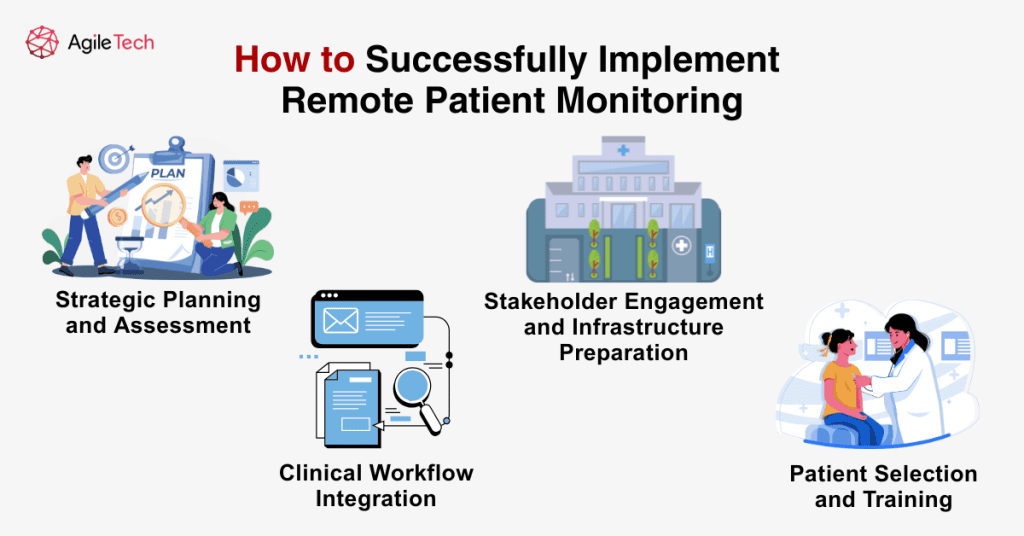
5.3. Clinical Workflow Integration
Clinical workflow integration planning addresses the fundamental challenge of incorporating remote monitoring data into existing care delivery processes without creating additional administrative burden or clinical complexity. Successful implementations require clear protocols for data review, alert management, patient communication, and intervention procedures. Healthcare organizations should develop standardized workflows that specify roles and responsibilities for different staff members while ensuring that monitoring data enhances clinical decision-making processes.
5.4. Patient Selection and Training
Patient selection and enrollment strategies determine the initial success and long-term sustainability of remote patient monitoring programs. Organizations should begin with patient populations most likely to benefit from remote monitoring while possessing the technical capabilities and motivation necessary for successful participation. Gradual program expansion allows healthcare teams to refine processes and address implementation challenges before scaling to larger patient populations.
Training and education programs ensure that healthcare staff and patients possess the knowledge and skills necessary for effective remote patient monitoring platform utilization. Clinical staff require training on data interpretation, workflow procedures, and technology troubleshooting. Patients need comprehensive education on device operation, data transmission procedures, and communication protocols with their healthcare providers.
6. AgileTech Experience in Remote Patient Monitoring Integration
Comprehensive Implementation Approach
AgileTech has established itself as a leading provider of remote patient monitoring integration services, combining deep healthcare technology expertise with a comprehensive understanding of clinical workflow requirements and regulatory compliance standards. Our experience spans multiple healthcare sectors, from small specialty practices to large integrated health systems, providing us with unique insights into the challenges and opportunities associated with RPM platform implementation.
Our approach to remote patient monitoring solutions begins with a comprehensive organizational assessment that evaluates current technology infrastructure, clinical workflows, patient populations, and strategic objectives. This thorough analysis enables our team to recommend optimal platform selections and implementation strategies that align with specific organizational needs and capabilities.
Technical Expertise and Project Management
AgileTech’s technical expertise encompasses the full spectrum of remote patient monitoring platform capabilities, from device integration and data transmission protocols to advanced analytics and clinical decision support systems. Our development teams possess extensive experience with healthcare data standards, interoperability requirements, and security protocols that ensure seamless integration with existing healthcare information systems.
Our project management methodology for remote patient monitoring integration emphasizes systematic implementation approaches that minimize disruption to ongoing clinical operations while ensuring comprehensive staff training and patient engagement. We utilize proven project management frameworks adapted specifically for healthcare technology implementations, including detailed planning phases, stakeholder communication protocols, testing procedures, and go-live support services.
Ongoing Support and Compliance
The breadth of our remote patient monitoring platform experience includes successful implementations across diverse healthcare specialties including cardiology, endocrinology, pulmonology, and primary care practices. We have supported organizations in implementing chronic disease management programs, post-acute care monitoring systems, and population health initiatives that leverage RPM capabilities to improve patient outcomes while reducing operational costs.
AgileTech’s commitment to ongoing support and system optimization ensures that our clients achieve maximum value from their remote patient monitoring investments. Our support services include system monitoring, performance optimization, user training programs, and platform enhancement recommendations that help healthcare organizations adapt their RPM capabilities as their needs evolve and technology advances.
7. Conclusion
Remote patient monitoring software represents a transformative technology that enables healthcare organizations to extend their care delivery capabilities beyond traditional clinical boundaries while improving patient outcomes and operational efficiency. The comprehensive benefits of RPM implementation extend from enhanced clinical surveillance and early intervention capabilities to substantial cost reductions and improved patient satisfaction metrics.
Successful adoption of remote patient monitoring solutions requires strategic planning, comprehensive stakeholder engagement, and systematic implementation approaches that address both technological and workflow considerations. Healthcare organizations must carefully evaluate available platforms to identify solutions that align with their specific clinical needs, technical infrastructure, and organizational objectives while ensuring seamless integration with existing care delivery processes.
The future of healthcare delivery increasingly depends on innovative technologies that bridge the gap between scheduled medical encounters and continuous patient care oversight. Remote patient monitoring platforms provide the foundation for this transformation, enabling healthcare providers to deliver proactive, data-driven care that prevents complications while optimizing resource utilization and improving patient experiences.
As healthcare organizations continue to face mounting pressure to deliver high-quality care while managing costs and addressing staffing challenges, remote patient monitoring software offers a sustainable solution that benefits patients, providers, and healthcare systems alike. The key to successful implementation lies in selecting appropriate platforms, developing comprehensive implementation strategies, and partnering with experienced technology integration specialists who understand the complexities of healthcare technology adoption.